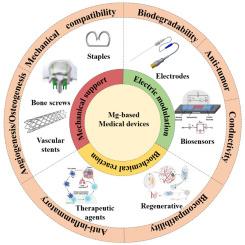可生物降解的镁基医疗设备:从被动支持到主动调制
IF 13.8
1区 材料科学
Q1 METALLURGY & METALLURGICAL ENGINEERING
引用次数: 0
摘要
可生物降解的镁(Mg)基医疗器械通过独特地结合生物相容性和机械强度,彻底改变了医疗植入物。完全可降解的镁基植入物已被开发用于提供临时结构支持,并作为组织修复和重组的动态支架。此外,镁基设备可以响应生理信号,并与电流或脉冲相结合,以促进组织愈合和功能恢复。本文综述了镁基医疗器械的发展和应用,重点介绍了镁基医疗器械从传统的骨科、血管和牙科应用到主动调节生理过程的先进系统的演变——从被动支持到主动调节的转变。镁基器械的应用范围已从早期的血管缝合线、骨螺钉、支架扩展到多孔骨修复支架、吻合钉、生物活性装置、电活性系统等多个临床领域。生物活性镁器件通过其降解产物展示了包括抗菌、抗炎、抗肿瘤和成骨功能在内的治疗特性,而电活性器件利用镁的电特性进行传感、监测和治疗刺激。最后,本文综述了当前面临的挑战,包括保持机械支持性能、优化生化反应控制和平衡电调节功能,并确定了未来的研究方向,旨在加强可生物降解的mg基植入物的临床应用,从而为生物医学领域的重大进步做出贡献。本文章由计算机程序翻译,如有差异,请以英文原文为准。

Biodegradable Mg-based medical devices: From passive support to active modulation
Biodegradable magnesium (Mg)-based medical devices have revolutionized medical implants by uniquely combining biocompatibility and mechanical strength. Fully degradable Mg-based implants have been developed to provide temporary structural support and serve as a dynamic scaffold for tissue repair and restructuring. Additionally, Mg-based devices can respond to physiological signals, and their integration with electrical currents or pulses has been explored to enhance tissue healing and functional recovery. This review provides a comprehensive overview of the development and application of Mg-based medical devices, highlighting their evolution from traditional orthopedic, vascular, and dental uses to advanced systems that actively modulate physiological processes—a shift from passive support to active modulation. The application range of Mg-based devices has expanded from early vascular sutures, bone screws, and stents to multiple clinical fields including porous bone repair scaffolds, anastomotic staples, bioactive devices, and electro-active systems. Bioactive Mg devices demonstrate therapeutic properties including antibacterial, anti-inflammatory, anti-tumor, and osteogenic functions through their degradation products, while electro-active devices utilize the electrical properties of Mg for sensing, monitoring, and therapeutic stimulation. Finally, this review highlights current challenges, including maintaining mechanical support performance, optimizing control of biochemical reactions, and balancing electro-regulatory functions, and identifies future research directions aimed at enhancing the clinical application of biodegradable Mg-based implants, thereby contributing to the significant advancement in the biomedical field.
求助全文
通过发布文献求助,成功后即可免费获取论文全文。
去求助
来源期刊

Journal of Magnesium and Alloys
Engineering-Mechanics of Materials
CiteScore
20.20
自引率
14.80%
发文量
52
审稿时长
59 days
期刊介绍:
The Journal of Magnesium and Alloys serves as a global platform for both theoretical and experimental studies in magnesium science and engineering. It welcomes submissions investigating various scientific and engineering factors impacting the metallurgy, processing, microstructure, properties, and applications of magnesium and alloys. The journal covers all aspects of magnesium and alloy research, including raw materials, alloy casting, extrusion and deformation, corrosion and surface treatment, joining and machining, simulation and modeling, microstructure evolution and mechanical properties, new alloy development, magnesium-based composites, bio-materials and energy materials, applications, and recycling.
 求助内容:
求助内容: 应助结果提醒方式:
应助结果提醒方式:


